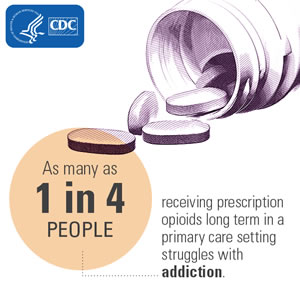By Rebecca Zimmerman, MD
The opioid crisis in America has had devastating effects on people across the country. You likely know someone who is struggling with addiction to prescription opioid pain medication or heroin, whether it is a family member, friend, neighbor, coworker, or yourself. In 2012, the National Institute on Drug Abuse estimated that 2.1 million Americans suffer from substance use disorders related to prescription opioids, and 467,000 are addicted to heroin. These numbers are rising. According to the Centers for Disease Control and Prevention (CDC), over 33,000 people died from an opioid overdose in 2015, more than any year on record.
The root of this crisis can be traced back to the 1990s, when doctors began prescribing opioids to treat chronic pain. Before that time, opioids were used mainly for post-surgical pain and end-of-life treatment. This changed after some medical experts and drug companies claimed that opioids could be used without addiction. This has since been proven false and misleading in court. Sales of prescription opioids in the US almost quadrupled from 1999 to 2014. During this time period, prescription opioid overdose deaths increased similarly.
Opioids are a family of drugs that include both illegal heroin and prescription pain medications such as oxycodone, morphine, and fentanyl. Prescription opioids and heroin have a very similar chemical structure. We have learned that nonmedical use of prescription opioids is a significant risk factor for heroin use. Opioids act on receptors throughout the body to reduce the perception of pain, but may also cause drowsiness, confusion, nausea, and constipation. They also create a sense of well-being and pleasure by increasing the level of dopamine that acts on the brain’s reward system. This can cause a person to intensely crave opioids and become addicted.
When used repeatedly over time, the body develops tolerance to opioids and requires higher doses to feel the desired effect. If a person takes a dose that is higher than their body’s tolerance level, the brain stops signaling for the lungs to breathe. This can lead to respiratory failure and death. Mixing opioids with other drugs or alcohol is very dangerous and increases the risk of overdose and death. The body can become physically dependent on opioids, causing withdrawal symptoms when the drug is stopped. Symptoms of withdrawal include anxiety, insomnia, muscle aches, nausea, vomiting, abdominal cramping and diarrhea. Withdrawal is not life threatening, but is extremely uncomfortable. The high risk of physical dependence and addiction to opioids makes stopping their use incredibly challenging for many people.
The opioid crisis in America has gained broad recognition that is spurring action by healthcare professionals, lawmakers, and communities. Main goals include improving opioid prescribing practices, expanding addiction treatment, and reducing access to illegal opioids. We have learned that long-term use of prescription opioids for chronic pain can be associated with abuse and overdose, and the risks outweigh the benefits for most people. United Family Medicine has implemented a clinic policy to provide our patients with effective and appropriate pain treatment while preventing chronic disability and dependence due to unnecessary, ineffective, and potentially harmful opiate prescriptions. We are dedicated to following strict guidelines when thinking about starting opioid therapy, and will always consider alternative pain management strategies first. Our policy is in line with recommendations from the CDC, who recently awarded the Minnesota Department of Health $585,000 to develop improved opioid overdose prevention plans in the state.
Additional important areas of focus include implementing harm reduction services that can reach people with opioid use disorders. Harm reduction approaches include providing broader access to needle exchange programs to help reduce the transmission of HIV and hepatitis C, broadening access to naloxone (an antidote to reverse an opioid overdose), and increasing availability of medication-assisted-treatment. If you or a loved one is struggling with an opioid use disorder, United Family Medicine can help. We are here to support you on your path to recovery. For more information on opioids, please visit:
• CDC Injury Prevention & Control: Opioid Basics at https://www.cdc.gov/drugoverdose/opioids/index.html
• U.S. Department of Health & Human Services – Opioids: The Prescription Drug & Heroin Overdose Epidemic at https://www.hhs.gov/opioids

